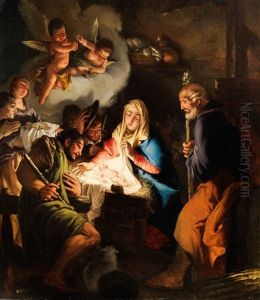Cesare Ligari Paintings
Cesare Ligari, born in 1716 in Sondrio, Italy, was a distinguished Italian painter and architect during the late Baroque and early Neoclassical periods. Though not as widely known as some of his contemporaries, Ligari made notable contributions to the art world, especially within the regions of Lombardy and more specifically in the Valtellina area, where he spent a significant portion of his life and career. His works are characterized by their intricate detail, vibrant colors, and the emotional depth they convey, typical of the Baroque period's dramatic style, yet they also begin to hint at the emerging Neoclassical aesthetic through their emphasis on clarity and simplicity.
Ligari's artistic journey was profoundly influenced by the cultural and artistic milieu of 18th-century Italy, a period marked by a transition from the grandeur and dynamism of Baroque art to the more restrained and classical approach of Neoclassicism. He received his initial training in his hometown but soon expanded his studies to include the major artistic centers of Italy, where he was exposed to the works of the masters. Despite the broader influences, Ligari remained deeply connected to his roots in Lombardy, where he executed most of his works, ranging from religious commissions in local churches to secular paintings for private patrons.
Throughout his career, Ligari demonstrated a versatility across different media, including painting, fresco, and architectural design, showcasing his broad talents not only as an artist but also as an architect. His architectural works, though less documented than his paintings, contributed to the aesthetic development of the region's ecclesiastical and secular buildings, blending functional design with artistic beauty. Ligari's legacy, though somewhat overshadowed by more prominent figures of his time, remains significant in the context of Italian art history, particularly for his contribution to the cultural heritage of Lombardy and the transition from Baroque to Neoclassical art.
Cesare Ligari died in 1770 in Sondrio, leaving behind a body of work that, while not extensive, is valued for its contribution to the period's artistic evolution. His paintings, characterized by their emotional expressiveness and technical skill, continue to be studied and appreciated for their place in the rich tapestry of Italian art. Ligari's life and work exemplify the vibrant artistic culture of 18th-century Italy and the ongoing dialogue between tradition and innovation that defined the era.









